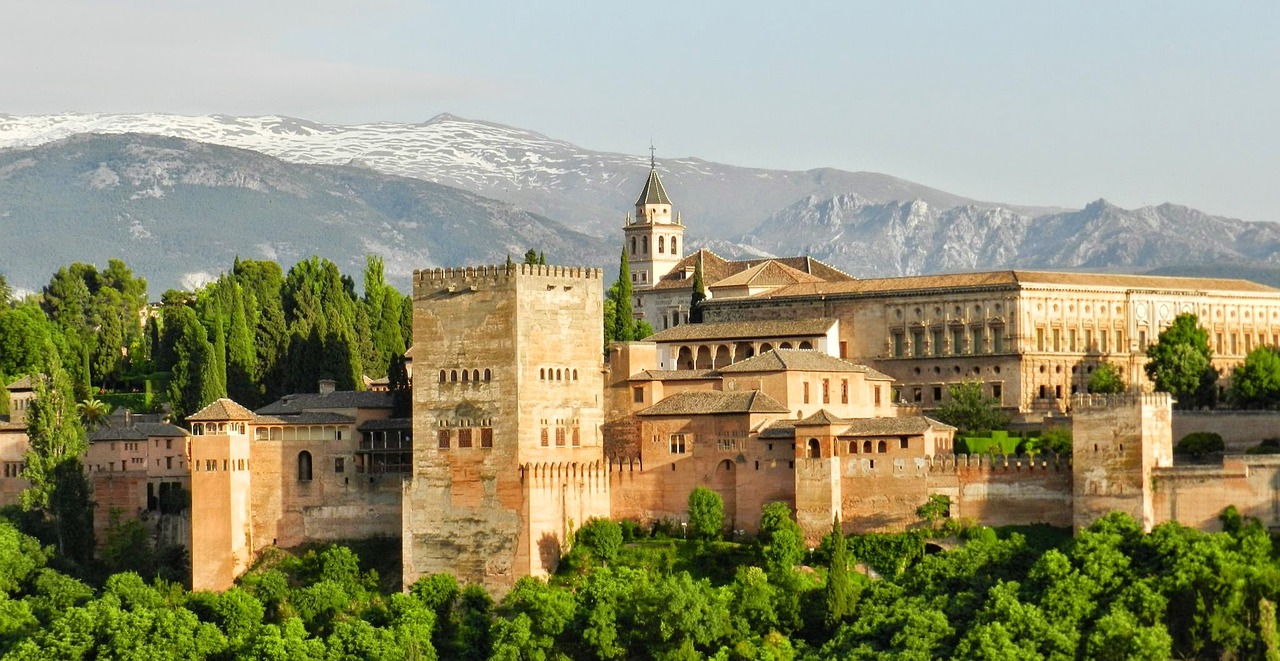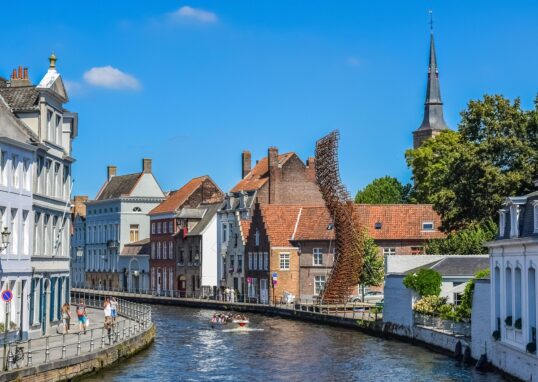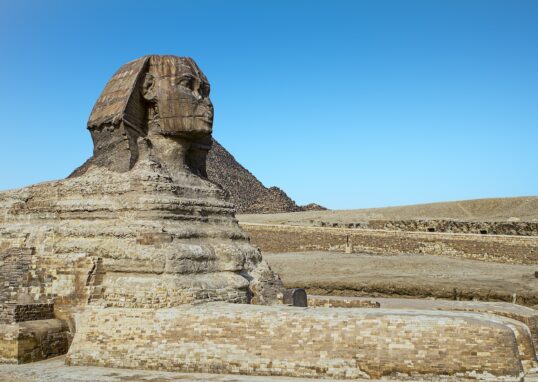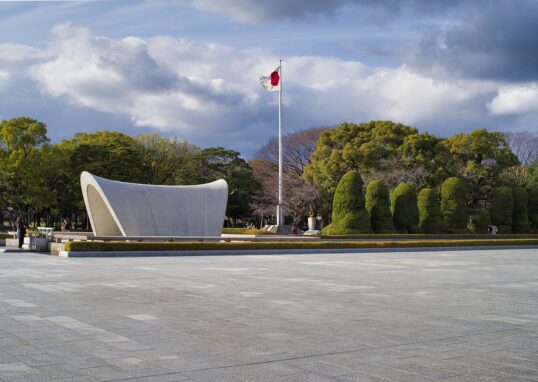
Alhambra Unbound: A Palace That Breathes Centuries of Forbidden Love
Granada’s Alhambra is a historic fortress and the famous palace of the Nasrid Dynasty. Alhambra is a historic place that was built over time from the 13th to the 14th century, with epic buildings and complex designs constructed within the natural habitat of the people of the time. The area was previously used for military purposes, but it is now utilized for construction and serves as a location for people to build their homes. The monument is said to represent the highest level of Islamic and cross-cultural unity, where art, science, and religion intersect. Alhambra, situated among the Sierra Nevada mountains of Granada, offers visitors a glimpse into Spain’s multicultural past and demonstrates why Spain is a melting pot of cultures in Europe.
The Alhambra is situated on a hill overlooking the city of Granada in southern Spain, one of the most prestigious and beautiful places in the world. There is a large palace and a complex, a UNESCO World Heritage Site, an excellent work of Islamic architecture, and a testament to the rich cultural heritage of Andalusia. The last Muslim ruler of Spain, built by the Nasrid dynasty during the 13th and 14th centuries, is a remarkable blend of art, history, and natural beauty that attracts visitors from around the world.
The name Alhambra is derived from the Arabic word for “the red fortress,” referring to the distinctive red color of the walls, which glow beautifully in sunlight. The complex is divided into several main areas, each with its unique attraction. Nasirid Palace is the crown jewel of Alhambra, featuring intricate plasterwork, ornate mosaic tiles, and a serene courtyard. Lions Court, with its prestigious fountains supported by twelve marble lions, symbolizes the palaces, Islamic art, and architecture.
History and Background of Alhambra, Granada, Spain
In 889, the Alhambra was established as a small stronghold. Years later, during the 13th century, the Nasrid sultan Mohammed Ibn Al-Ahmar transformed it into a complex of monumental edifices, including palaces, courts, fountains, and gardens. Actually, under the rule of Yusuf I and Mohammed V, during the latter half of the 14th century, the Alhambra was initiated in developing the architectural complex we have in place when we visit next time. However, due to the capture of the region by the Christian King Ferdinand II in 1490, when the reconquest was completed, some changes were made in the Alhambra. Still, mainly the Spanish Royalty used the Alhambra, and Charles V made a palace in Renaissance style within the Alhambra. However, the site has retained its Moorish character, and some of the Islamic structures have also remained, allowing one to feel its history and culture.
Architectural Style and Features
The Alhambra is often referred to as a piece of heaven that unfolds against a breathtaking landscape. The complex employs equilibrium, symmetry, and ornamental detail, evoking the sources of wonder. It combines Islamic art and architecture, which is presented through Moorish elements, calligraphy, stucco, and stalactites, such as muqarnas. The construction of all these is mainly due to the Nasrid artisans, who are described as masters of such work.
Nasrid Palaces
The Nasrid Palaces have three separate sections and are the heart of the Alhambra.
- The Mexuar Hall: Initially, the king used it as a court to resolve legal matters, and it is adorned with elaborate tilework and calligraphy. Although partially destroyed during the Christian era, this hall retains a significant Moorish influence.
- Comares Palace: At this site, unique items, including the massive Comares Tower, which features mosaics and stained glass, were displayed, and a magnificent wooden ceiling with 8,017 pieces was crafted.
- Palace of the Lions: Anticipated by ornate stone lions supporting a fountain, the Palace of the Lions is classified as a peerless Islamic work of art in the Alhambra. The Court of Lions is a real paradise with water channels depicting the Islamic Eden’s four rivers. The construction method employed here combines an Islamic ethos of artistry with mathematical precision. On this are arches and muqarnas, whose mathematical precision is coupled with the space’s aesthetic appeal.
Generalife Gardens
Generalifa was the summer residence for the monarchs of the Nasrid dynasty. In the scorching times of Lent, they had opportunities to get away from the matters of the throne and enjoy themselves in the palace. The gardens are the most pleasant free space to spend time, allowing you to unwind without disturbing your thoughts. They are carefully designed assets that are well-integrated with the functions and the design of your feelings from the outset. Through the attentive landscape architecture, aromatic gardens, and refreshing water features, the Generalife Gardens are outstanding in their achievement of a kind of garden architecture found in medieval Islamic landscapes.
Symbolism and Artistic Details
The uniqueness of the Alhambra lies not only in its beauty, which captures the eye but also in its profound and deeply rooted reflections of cultural symbolism. The primary target of artwork is the masterpieces that truly mirror their respective cultures. Reading the lines of Arabic inscriptions, which could be from any poetry or Quranic text, offers an intimate glimpse at the spiritual and philosophical understandings of the Nasrid rulers. Phrases like “There is no victor but God” are inscribed on the walls of the palaces, symbolizing the Muslim faith of the compound’s builders. Thus, by the use of abstract methods, spiritual notions became more intensified and explored.
This architectural wonder’s major distinctive factor is its complex geometric patterns and arabesques, avatars of God’s unity and infinity. These graphics serve as the medium through which Islamic art is communicated. On the one hand, they are used solely for decorative purposes. Parallel to this, there are also religious symbols, such as the Moon and the Sun.
Christian Influence and Renaissance Additions
When Granada was under Christian control in 1492, the Alhambra underwent various structural changes. The Renaissance-like Palace of Carlos V (C. of the Fifth), raised by the King, transformed it from the Moorish architecture of the first king to the icing grace of the palaces of the glorious architect. Transformation is everywhere in life, and people can observe the change of the Alhambra from an Islamic realm to a Christian society, as well as the blending of various cultures.
Visiting the Alhambra: Practical Information
Of all the premier tourist centers in Spain, the site is the second most popular, attracting over 3,000,000 tourists annually. Due to the site’s high demand, booking your tickets in advance is strongly recommended, as they can sell out, especially during the spring and fall seasons. It is divided into several areas where the tickets are purchased separately: Nasrid Palaces, Generalife, and Alcazaba. You are advised not to spend less than 3-4 hours as the minimum duration for the visit.
The guided tours help tourists learn the meaningful implications of each part’s history, architecture, and significance. On the other hand, these evening tours create a distinct atmosphere due to the lighting of the palaces, which highlights the intricate details of the art and architecture.
Nearby Attractions and Surrounding Area
The Alhambra is situated on a hill known as Sabika, specifically in the Albayzin quarter of Granada, a UNESCO World Heritage site characterized by its deep, narrow, and steep streets, as well as a mix of winding and whitewashed dwellings. In this area, tourists can enjoy a picture-perfect view of the Alhambra, primarily from the Mirador de San Nicolas viewpoint.
Granada boasts an intricate blend of Islamic and Spanish influences, evident in features such as the Granada Cathedral, Royal Chapel, and the Alcaicería, a historic marketplace. The lively districts, tapas, bars, and flamenco performances make Granada more charming than the Alhambra alone.
Cultural Significance and Preservation Efforts
Not only is Alhambra a stunningly magnificent piece of engineering, but it also represents Spain’s complicated history of peaceful coexistence, conflict, and cultural exchange between the Islamic and Christian worlds. Over many centuries, it has inspired artists, writers, and musicians, from Washington Irving´s “Tales of the Alhambra” to the art of M. C. Escher.
Uninterrupted conservation initiatives are the key to preserving this UNESCO World Heritage Site. Modern technology, such as 3D scanning and digital modeling, is currently being used to monitor the health of the complex and address degradation caused by natural erosion, tourism, and environmental factors.
Conclusion
Another area that must be seen normally is the Summer Palace and the Nerid rulers’ gardens. Fountains, flowering plants, and shaded walkways filled with collections provide a remarkable setting and fantastic views of the kitchen gardens and the lower part of town. Charles V’s palace, a Renaissance-style building added to Granada during the Christian conquest, contrasts with Islamic architecture and is featured in the houses of the Alhambra Museum and the Fine Arts Museum. Travelers also enjoy visiting Old San Juan, also known as Viejo San Juan, the Spanish colonial name for the historic quarter of the capital. Old San Juan was the first town brought to life in Puerto Rico by the ancient El Dorado of Hope. It is the oldest part of San Juan to be recognized for its classic architecture, forts, and history.
The Alhambra is not only a monument for tourists to gaze at but also a reflection of the relationships between various nationalities that lived in Spain. It offers a combination of beauty, spirituality, and art, serving as a monument to Spain’s multicultural past. People visit the Alhambra and return to a time when Islamic art and architecture were in vogue in Europe. This factor creates an environment that captivates both the eyes and the soul simultaneously. From the intricacy of the Nasrid palaces to the beauty of the Generalife’s gardens, the Alhambra remains an immense testament to the past that enchants tourists worldwide.









